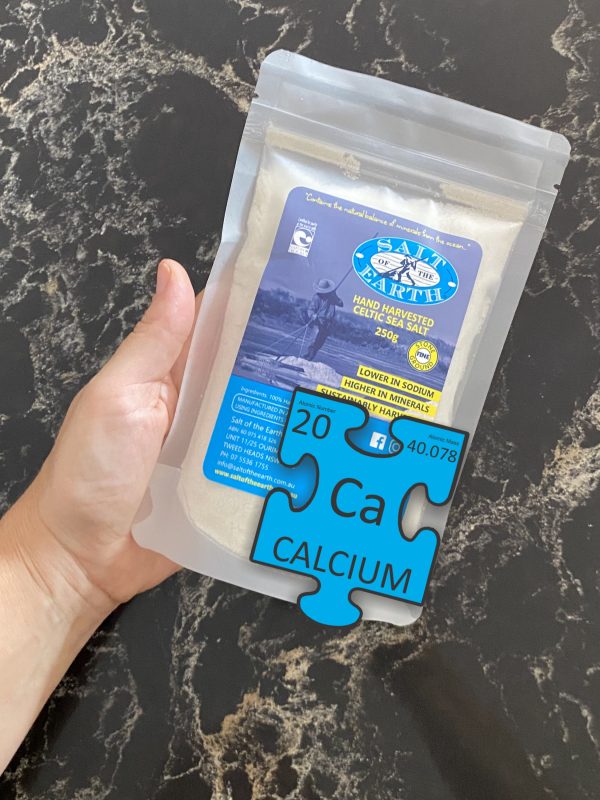Categories
Calcium – More Than Just Bone Health
 When we think of calcium we think of healthy bones and teeth. This essential mineral also plays an important role in blood clotting, helping muscles to contract, and regulating normal heart rhythms and nerve functions. Approximately 99% of the body’s calcium is stored in bones, and the remaining 1% is found in our blood, muscles, and other tissues.
When we think of calcium we think of healthy bones and teeth. This essential mineral also plays an important role in blood clotting, helping muscles to contract, and regulating normal heart rhythms and nerve functions. Approximately 99% of the body’s calcium is stored in bones, and the remaining 1% is found in our blood, muscles, and other tissues.
To assist with our body’s vital daily functions, it works hard to keep a steady amount of calcium in our blood and tissues. If calcium levels drop too low in the blood, parathyroid hormone (PTH) will take from our bones to release calcium into the bloodstream and may also activate vitamin D to assist in the absorption of calcium in our intestines. This hormone also signals the kidneys to release less calcium in the urine. On the other hand, when our bodies have enough calcium, a hormone called calcitonin works to do the opposite: it stops the release of calcium from the bones to lower calcium levels in our blood and signals the kidneys to expel more calcium in our urine. Ideally, the calcium that is “borrowed” from our bones will be replaced at a later point. But this does not always happen.
Signs of Calcium Deficiency
As our body is constantly regulating the levels of calcium in our blood, no symptoms usually occur. Hypocalcemia is a more serious deficiency of calcium which is a result of diseases such as kidney failure, surgeries of the digestive tract like gastric bypass, or medications like diuretics that interfere with absorption.
Symptoms of hypocalcemia:
- Poor appetite
- Muscle cramps or weakness
- Abnormal heart rate
- Numbness or tingling in fingers
People who do not get enough dietary calcium over long periods of time or who lose the ability to absorb calcium can have a gradual progressive calcium deficiency occur. The first early stage of bone loss is called osteopenia and, if untreated, osteoporosis follows. Examples of people at risk include:
- Postmenopausal women due to a lowered amount of estrogen in the body.
- Amenorrhea—A condition where menstrual periods stop early or are disrupted, often seen in younger women with anorexia nervosa or athletes who physically train at a very high level.
- People with a milk allergy or lactose intolerance
Signs of Calcium Toxicity
Too much calcium in the blood is called hypercalcemia. Some research has shown that in certain people, calcium can accumulate in blood vessels with long-term high doses and cause heart problems. Calcium is also a large mineral that can block the absorption of other minerals like iron and zinc.
Symptoms of hypercalcemia:
- Weakness, fatigue
- Nausea, vomiting
- Shortness of breath
- Chest pain
- Heart palpitations, irregular heart rate
Recommended daily amount
| Men | |
| 19-50 years | 1,000 mg |
| 51-70 years | 1,000 mg |
| 71 and older | 1,200 mg |
| Women | |
| 19-50 years | 1,000 mg |
| 51 and older | 1,200 mg |
Please note these RDAs are established with an understanding of calcium bioavailability in food.
Sources of Calcium
We are all aware that milk, yogurt, and cheese are rich natural sources of calcium. In the Australia, approximately 72% of calcium intakes come from dairy products and foods with added dairy ingredients. Nondairy sources include canned sardines and salmon with bones as well as certain vegetables, such as kale, broccoli, and Chinese cabbage (bok choy). Most grains do not have high amounts of calcium unless they are fortified. However, they contribute to calcium intakes, even though they contain small amounts of calcium, because people consume them frequently. Foods fortified with calcium include many fruit juices and drinks, tofu, and ready-to-eat cereals. Calcium citrate malate is a well-absorbed form of calcium used in some fortified juices.
Calcium is a large mineral and not easily broken down in the gut. The calcium listed on the Nutritional Facts Label of a food product is the measure of calcium in the food, not necessarily the amount our bodies will absorb. The amount that is actually absorbed and used by the body is called “calcium bioavailability.” Some foods have a higher calcium bioavailability than others. For example, dairy foods have a bioavailability of about 30% absorption so if a food label on milk lists 300 mg of calcium per cup, about 100 mg will be absorbed and used by the body. Plant foods like leafy greens contain less calcium overall but have a higher bioavailability than dairy. For example, bok choy contains about 160 mg of calcium per 1 cup cooked but has a higher bioavailability of 50%, so about 80 mg is absorbed. Therefore, eating 1 cup of cooked bok choy has almost as much bioavailable calcium as 1 cup of milk. Calcium-fortified orange juice and calcium-set tofu have a similar total amount of calcium and bioavailability as milk, while almonds have slightly lower total calcium and bioavailability of about 20%. Some plant foods contain anti-nutrients such as oxalates and phytates that bind to calcium and decrease its bioavailability. Spinach contains the most calcium of all the leafy greens at 260 mg of calcium per 1 cup cooked, but it is also high in oxalates, lowering the bioavailability so that only 5% or about 13 mg of calcium can be used by the body. While spinach cannot be relied up as a significant source of calcium, it still contains many other valuable nutrients.
List of Foods
- Dairy (cow, goat, sheep) and fortified plant-based milks (almond, soy, rice)
- Almonds
- Edamame (young green soybeans); Tofu, made with calcium sulfate
- Calcium-fortified orange juice
- Canned sardines, salmon (with bones)
- Leafy greens (collard, mustard, turnip, kale, bok choy, spinach)
- Squash
- Salt of the Earth Celtic Sea Salt
Supplements
Calcium is available in many dietary supplements, including multivitamin/mineral products and supplements containing calcium only or calcium plus vitamin D. Amounts of calcium in supplements vary widely; multivitamin/mineral supplements commonly contain about 200 to 300 mg, and common amounts in calcium or calcium plus vitamin D supplements are 500 or 600 mg. The two most common forms of calcium in supplements are calcium carbonate and calcium citrate. Calcium citrate is less dependent on stomach acid for absorption than calcium carbonate, so it can be taken without food, however, absorption of calcium supplements is greater when they are taken with food, regardless of whether the user’s gastric acid is low. The percentage of calcium absorbed from supplements, as with that from foods, depends not only on the source of calcium but also on the total amount of elemental calcium consumed at one time; as the amount increases, the percentage absorbed decreases. Absorption from supplements is highest with doses of 500 mg or less.
References
- Institute of Medicine. Dietary Reference Intakes for Calcium and Vitamin D. Washington, DC: The National Academies Press; 2011.
- Wawrzyniak N, Suliburska J. Nutritional and health factors affecting the bioavailability of calcium: a narrative review. Nutr Rev 2021. [PubMed abstract]
- Gallagher JC, Yalamanchili V, Smith LM. The effect of vitamin D on calcium absorption in older women. J Clin Endocrinol Metab 2012;97:3550-6. [PubMed abstract]
- Cormick G, Betrán AP, Metz F, Palacios C, Beltrán-Velazquez F, García-Casal MLN, et al. Regulatory and policy-related aspects of calcium fortification of foods. Implications for implementing national strategies of calcium fortification. Nutrients 2020;12. [PubMed abstract]
- Marshall K, Teo L, Shanahan C, Legette L, Mitmesser SH. Inadequate calcium and vitamin D intake and osteoporosis risk in older Americans living in poverty with food insecurities. PLoS One 2020;15:e0235042. [PubMed abstract]

